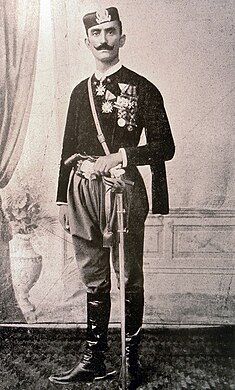Aleksandar Lekso Saičić
Aleksandar Saičić | |
|---|---|
 Aleksandar Lekso Saičić | |
| Native name | Александар Саичић |
| Nickname(s) | Lekso |
| Born | 5 August 1873 Vinicka, Principality of Montenegro |
| Died | 7 April 1911 (aged 37) Cetinje, Kingdom of Montenegro |
| Allegiance | |
| Rank | Lieutenant |
| Battles/wars | Russo-Japanese War |
This article's factual accuracy is disputed. (September 2021) (Learn how and when to remove this template message) |
Aleksandar Lekso Saičić (Serbian Cyrillic: Александар Лексо Саичић; 5 August 1873 – 7 April 1911) was a Montenegrin army officer. He was from the Vasojević tribe. Several sources exist that describe Saičić engaging in hand-to-hand combat with a Japanese officer during the Russo-Japanese War.[1][2]
Biography[edit]
Saičić studied at the gymnasium in Cetinje as a cadet of Prince Nikola.[clarification needed] He graduated from high school in Dubrovnik from where he moved to Belgrade where he attended the Military School. After a non-commissioned school,[clarification needed] he had been in Montenegro for three years, where he had been appointed as the aide of the Vasojević Brigade. As a soldier with a desire for further training, he went to Istanbul where he entered the Ottoman Army as a lieutenant of the Imperial Guard where he served for three years.[3]
Saičić participated in the Russo-Japanese War. The Montenegrin detachment in that war was led by Jovan Lipovac. Saičić was remembered[ambiguous] for killing a Japanese officer in a duel before the battle[ambiguous] in 1905. Because of this victory, he was decorated with the Russian Order. The Russian government ordered him forty Napoleons annually for the rest of his life. In Manchuria, he was promoted to the rank of captain and until the end of the war commanded the cavalry of the Dragon regiment. The saber which Lekso won the duel with is preserved today at the Military Museum in Moscow.[2]
He was awarded the following medals: St. Anne and St. Stanislaw of II class with swords, St. Vladimir of III class with Swords, St. Anne and St. Stanislaw III Class with Swords, Russian Medal of Wounded in Wars, Medal of the Italian Crown of IV class.[citation needed]
The Montenegrin medals he received were the Medal of Danilo First of IV class and the Silver Medal for Bravery.[citation needed]
In 1911, Saičić died after jumping from the second floor of the King's Palace in Cetinje during a fire while he was trying to save rare books that were kept there. He was buried with the highest military honors.[4]
References[edit]
- ↑ "Crnogorac Aleksandar Lekso Saičić posjekao 1905. u dvoboju japanskog samuraja". Montenegrina.net. March 5, 2019. Archived from the original on 28 January 2010. Retrieved 3 March 2019. Unknown parameter
|url-status=ignored (help) - ↑ 2.0 2.1 "Lekso sabljom stekao slavu!". www.novosti.rs (in српски / srpski). Retrieved 2020-07-05.
- ↑ "Promovisana knjiga Aleksandar Lekso Saičić". Mladiniksica.me. March 3, 2019. Retrieved 3 March 2019.
- ↑ "DRAGULJI ISTORIJE: Kako je Crnogorac Lekso Saičić u dvoboju pośekao samuraja". PortalAnalitika.me. April 7, 2016. Retrieved 7 April 2016.
- "MONTENEGRINA - digitalna biblioteka crnogorske kulture i nasljedja - Istorija - Dr Đuro Batrićević - Crnogorac Aleksandar Lekso Saičić posjekao 1905. u dvoboju japanskog samuraja". 2010-01-28. Archived from the original on 2010-01-28. Retrieved 2021-09-28.
- "Двобој у Манџурији | Politikin Zabavnik". politikin-zabavnik.co.rs. Retrieved 2021-09-28. „Двобој у Манџурији: САМУРАЈУ НА ЦРТУ “, Политикин Забавник
This article "Aleksandar Lekso Saičić" is from Wikipedia. The list of its authors can be seen in its historical and/or the page Edithistory:Aleksandar Lekso Saičić. Articles copied from Draft Namespace on Wikipedia could be seen on the Draft Namespace of Wikipedia and not main one.
